| Unionism |
|---|
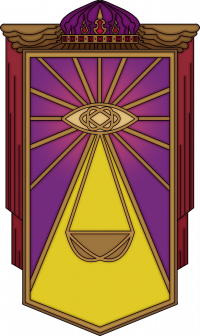 |
| Religion |
|---|
| Pronunciation |
Yoon-yen-is-m |
|---|
| Origins |
Emperor Theomar |
|---|
| Deities |
|---|
|
The Everwatcher and various other Gods and Goddesses |
| Subsects |
|---|
|
|
Origins
Unionism as a religion was created in the year 5 AC when Emperor Theomar (the founding Emperor of Regalia) proclaimed the Creed (the holy Scripture) as visions received from the Everwatcher. In the beginnings of the Empire, the faith was slow to spread, but through providence and divine intervention, as well as Regalia's military spread and aggressive missionary proselytizing, Unionism quickly spread from its small cult-like origins to a world-religion. It has over the years also absorbed Gods from smaller religions, and included Gods form other Religions to become a very all-inclusive cosmopolitan Religion. While most other Religions are Race specific with some caveats, Unionism is a cross-Race religion that invites all Races to join under the Everwatcher.
Schisms
Unionism has had a series of schisms in the past centuries, notably the Evintarian schism which was the result of dogmatic differences and a civil war, and the Supremoclast schism which followed a more critical and humanist conscience of the people. This resulted in the Religion splitting in three (with some smaller cults that were later re-absorbed) that engaged in some degree of religious war on each other to proclaim supremacy over the concept of the Everwatcher. It took several centuries, but in recent times, the conflict wounds healed, and the priests of all Schisms came together to re-merge the religious communities, founding the Unionist Divine, which represents the current faith and priesthood. Some Cults like the Evintarian and Guided Cult still exist, however these add optional additional Gods, rather than radically diverging from religious beliefs.
Core Beliefs
Unionism is a polytheistic Religion with one single superior being and his mortal vessel on earth, and a whole host of paired Gods who all offer specific lessons of the faith. The Religion's primary objective is world domination, that is to say, to create a globe-spanning Regalian Empire that can create eternal peace and stability, and bring about paradise by banishing war and suffering and death, and bring back all the dead from the Afterlives into an eternal paradise. Each of the God Pairs (except the Vessel) provides what the Unionists call, a Golden Lesson, which acts like a virtue, and opposes a sin in the belief of Unionism. If a person dies and their soul is judged by the Everwatcher they are found to be virtuous, they join the Everwatcher on the Great Stairway where they watch down on the living in wait for paradise to come. If they are deemed sinful, they are re-incarnated in the mortal world, so they are given another chance. The following Golden Lessons can be found in Unionism:
- Theomar and Thedmir: The Golden Lesson preaches that Unionism is good, and that spreading the faith is a virtue, and that sin is turning away from the Great Way, or outright sabotaging its intent.
- Ness and Eora: The Golden Lesson preaches that kindness and compassion are good things, and that even the most criminal seek love and affection and are deserving, while sin is to be bereft of mercy.
- Juvin and Glanzia: The Golden Lesson preaches that virtue is with the pure soul not tainted by the corrupt powers, and with knowing pure fact from wrong, while sin is spreading corruption and false information.
- Allest and Brand: The Golden Lesson preaches that loyalty to the state, the army, and fellow believers is a virtue, as is physical strength, and that sin is treason, deceptiveness without morals, and adultery.
- Elia and Leona: The Golden Lesson preaches that responsibility and protecting society is shared by everyone, no one can be excused, and that sin is to indifferent and not watching for the dangers of the world.
- Neal and Nolven: The Golden Lesson preaches that culture and art fill the soul with light, and that even in the darkness of war is beauty, and that sin is pure blind hatred without grace or beauty.
- Al-Asir and Marani: The Golden Lesson preaches that Technology brings forth great progress, and to share with society is a virtue, and that sin the creation of killing machines that automate death.
- Tanthor and Dari: The Golden Lesson preaches that even the most wretched, unwanted, and outcast of society have a role in the Great Way, and that sin is to find sadism and satisfaction in hurting the unloved.
- Mendes and Hor: The Golden Lesson preaches that wealth is there to be shared, but ultimately needed for the greatness of the faith, and that sin is to hoard wealth alone, and to steal from others.
- Sinnavei and Eirlys: The Golden Lesson preaches that even those outside the Faith can have an indispensable role to fill in paradise, and that sin is the wanton destruction of all that is alien and unknown.
- Caan and Kaldric: The Golden Lesson preaches that Magic and the Occult are a tainted burden that come with great responsibility, and that virtue can be found in good use, and sin in selfish destructiveness.
Gods and Goddesses
Unionism differs from other Religions, in that it has Duo-Gods. All Duo-Gods are divine and each have divine powers in the afterlife (though some Gods may be yet living). Unionists worship all Gods equally, though they may choose specific Patron gods which they worship more. The Everwatcher acts like an overarching God of Gods, but the Everwatcher cannot directly be interacted with, so most people end up praising the Everwatcher through the Gods and Goddesses. Unionism also has the Cults further below. Cults add Gods onto the standard Pantheon, but they are not mandatory for vanilla Unionists who don't worship the Cults. It is possible to be a believer of both Cults.
Prophet Gods Theomar and Thedmir
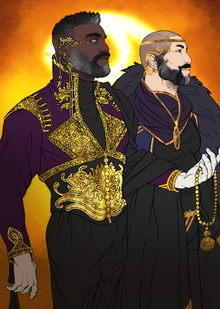
- Name: Theomar (left) and Thedmir (right), the Prophet Gods, first believers.
- Patron: Fathers, Rulers, Nobles, Leaders, Commanders, and Best Friends.
- Symbols: Theomar and Thedmir are symbolized by the necklace of friendship.
- Role: Theomar and Thedmir were the Prophets of Unionism, spreading the faith.
- Traits: Patriarchy, Insight, Good Governance, Loyalty, Friendship, Faith.
- Temple: The All-Beacon Temple in Regalia proper, the largest Unionist Temple.
- Allies: Regulus Worshipers, Dáuw Worshipers, anyone in the military.
- Enemies: In essence all Evolist worshipers, and all Vola Fornoss Gods.
- Rituals: Theomar and Thedmir Rituals involve re-enacting the struggles of them in the early days of Unionism. This involves preaching the faith to non believers, aiding the faithful in the defense of their holy shrines and places of worship, to mediate and act as diplomat for embattled groups, and to provide spiritual guidance to the Military. Theomar and Thedmir also have rituals concerning the sanctification and re-affirmation of friendship.
|
|
Mother Gods Ness and Eora
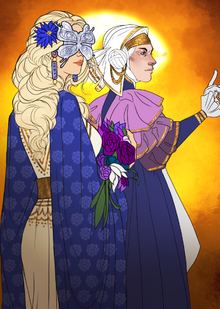
- Name: Ness (left) and Eora (right), Empress and Chancellor in life.
- Patron: Mothers, Healers, Caretakers, Protectors, Empaths, Martyrs.
- Symbols: Ness's Butterfly Mask, and the Habit (head scarf) of Eora.
- Role: Ness and Eora are the savior Goddesses of Unionism who care for believers.
- Traits: Protective, Motherly, Nurturing, Caring, Self-Sacrificing, Forgiving.
- Temple: The Temple of Salvation in Old-Town forest side, which doubles as Hospital.
- Allies: Leif Worshipers, Severena Worshipers, Daiana Worshipers, Medics of any Faith.
- Enemies: Murderers, people who adopt adults, people who attack medics/the unarmed.
- Rituals: Ness and Eora rituals are all about forgiveness and nurturing and healing others. This may involve taking confessions, but can also involve volunteering at a medical station or healing house. Furthermore, Ness and Eora faithful travel prisons and downtrodden areas to give forgiveness to the damned, and offer them love and kindness where there is only the cold sting of rejection and apathy to the fates of the forgotten.
|
|
Pure Gods Juvin and Glanzia
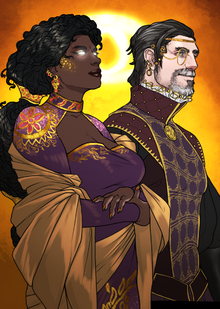
- Name: Glanzia (left) Goddess of Pure Soul, and Juvin (right) God of Pure Reason.
- Patron: Intellectuals, Mundanes, Anti-Magi, Scholars, Teachers, Archeologists.
- Symbols: Books with the Unionist Eye and Black Granite statues of Heroes.
- Role: To teach the faithful purity of soul (Magic-apprehension) and Logic.
- Traits: Analytical, Apprehension, Thoughtfulness, Anti-Magical, Purist.
- Temple: Temple of Greater Understanding, which doubles as a Library.
- Allies: Lothar Knights, Melca Worshipers, Severena & Aurora Worshipers.
- Enemies: Mage-Radicals, Theurgists, Those with Demon/Arken Pacts and Deals.
- Rituals: Rituals belonging to Juvin and Glanzia usually involve the Rites of Investigation. This usually involves an in-depth investigation to some kind of mystery, for Juvin that being discovery of new information and publication to the masses, and for Glanzia to uncover hidden Mage sand the Occult, and to warn the general public. General rituals and customs also just involve educating the masses on general factual information and debates of skill.
|
|
Martial Gods Allest and Brand
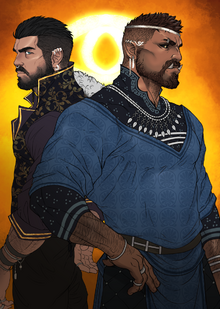
- Name: Allest (right) God of Warriors, Brand (left) God of Gladiators.
- Patron: Soldiers, Generals, Commanders, Gladiators, Warriors, Homosexuals.
- Symbols: Two crossed holy swords, one with blood, and one dripping with tears.
- Role: To encourage fraternity and loyalty in the army, and strength of arms in warriors.
- Traits: Brave, Boisterous, Glorious, Victorious, Martial, Dependable, Unwavering.
- Temple: The Divine Heroic Contemplation Temple in Gloomrot Forest in Regalia.
- Allies: Cemaan Worshipers, Bard & Njal Worshipers, Bloodcast Knights.
- Enemies: Pacifists, cowards, enemies of Unionism and those who attack Priests.
- Rituals: Allest and Brand were lovers in live and death, where most of their rituals involve some kind of brotherly oath, a promise to protect someone until one's dying breath, or swearing fealty and undying loyalty to an overlord in war. Allest and Brand were glorious warriors each in their own right, so in many ways, prayer before battle and battle itself is a form of worship in their names, as is love persevering through war.
|
|
Protector Gods Elia and Leona
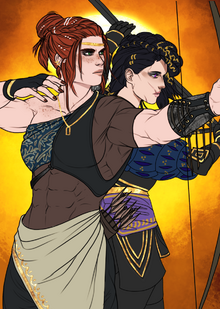
- Name: Elia (left) Goddess the Watchful Gaze, and Leona (right) Goddess of Knights.
- Patron: Guards, Knights, Hunters, Rangers, Explorers, Scribes, and Lesbians.
- Symbols: Elia's Longbow and Leona's Blacksteel sword, along with Blacksteel in general.
- Role: To teach the faithful to guard one another and be responsible for one another.
- Traits: Chivalrous, Alert, Mindful, Responsible, Dedicated, Precise, Awareness.
- Temple: Temple of Unyielding Overwatch which doubles as the Imperial Hunting Lodge.
- Allies: Urlan, Knights of all Kind, Metropolitan Guards, Tame Marken, Huntsmen.
- Enemies: Criminals, Monsters in the wild, Kathar, Argentum Knights, Womanizers.
- Rituals: Elia and Leona were lovers in life and death, where most of their rituals involve some kind of communal or co-operative practice of the hunt or respect and support of the Knights (as well as being Knights). Knighthood is considered the greatest form of "keeping watch over society", and so many of their patrons become Knights. Other forms of rituals are couple or group hunts, and inspections of garrisons and walls and armories.
|
|
Vessel Gods Alexander and The Everwatcher
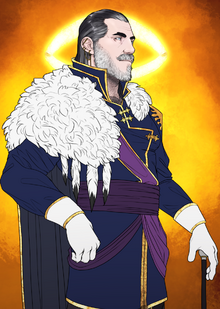
- Name: Alexander (see) Emperor of Regalia and The Everwatcher (not depicted).
- Patron: Alexander is the Vessel of the Everwatcher, He speaks through him only.
- Symbols: The Unionist Eye represents the Everwatcher, the Crown Alexander.
- Role: To be living embodiment of the divine will of the Everwatcher in Regalia.
- Traits: Divine, Sagely, Wise, All-Loving, All-Inclusive, All-Caring.
- Temple: The Imperial Palace in essence doubles as the Temple of the Vessel.
- Allies: Alexander is ostensibly an Ally of all and everyone who will listen.
- Enemies: He has no Enemies. Even those who reject him in Crookback get his love.
- Rituals: There aren't strictly any rituals for Alexander, as he is only the Temporary Vessel. When Alexander dies, the next Emperor will take his place as the Vessel God, so that only ever the living Emperor will be Vessel God. It's also worth noting that Gladiator God Brand's name in life was also Alexander, as Brand is Alexander's ancestor. The latter is styled "Alexander II", the former has the Divine name of Brand from his living nickname Bram.
|
|
Culture Gods Neall and Nolven
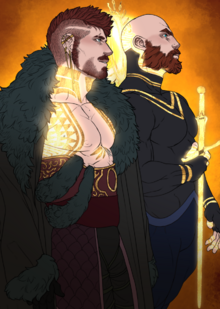
- Name: Neall (left) is the God of Visual Arts, Nolven (right) is the God of Military Arts.
- Patron: Painters, Sculptors, Make-up Artists, Fashion Designers, Gardeners, Designers.
- Symbols: Nolvens's golden radiant sword, or Neall's golden radiant paintbrush / pencil.
- Role: To teach the faithful the facets of culture in peace and war, and to love art.
- Traits: Creative, Artistic, Expressive, Gregarious, Welcoming, Inclusive, Visual.
- Temple: Temple of the High Arts inside the Imperial Palace Art Galleries.
- Allies: Artists, Njall Fornoss Worshipers, Viridian Knights, Beauty Arkenborn.
- Enemies: Argentum Knights, the Mutated and Monstrous, Evolist Worshipers.
- Rituals: Neall and Nolven's rituals invariably involve the combination of cultural beauty and the art of war, whether that is a dramatic renaissance-style painting of a battlefield, or finding ways to depict what is in essence militarist propaganda in beautiful ways (statues, poetry, literature, art, etc). Because art is a skill, most worshipers of Neall and Nolven tend to perform their worship by paying artists to make art, a form of patronage.
|
|
Inspired Gods Al-Asir and Marani
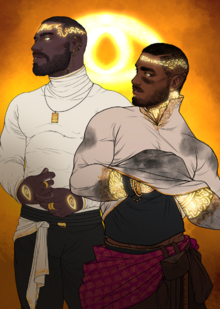
- Name: Al-Asir (right) the God of Invention, and Marani (left) the god of Inspiration.
- Patron: Technicians, Engineers, Inventors, Architects, Craftsmen, Laborers.
- Symbols: Al-Asir's golden gears, or Qadir Ailor arm tattoo shapes in glowing gold.
- Role: Divine inspiration and guard against inventions of Evil in Technology.
- Traits: Eureka, Technical, Resourceful, Inspired, Altruistic, Conscientious.
- Temple: The Telocator Temple in Al-Alus, the only one outside Regalia's Empire.
- Allies: Those that help society at large, Those that make everyone's lives easier.
- Enemies: Death Cultists, Rishiq Qadir, Machinist Worshipers, War-Machine Inventors.
- Rituals: Al-Asir and Marani rituals involve the act of inventing, or just tinkering with technology, reading books and improving skills, or just generally engaging in crafts from simple wood carving furniture to advanced architectural planning. The act of production for someone else, even at the cost of payments, is considered da virtuous activity for the patron Gods of Craftsmen, this is why object creations are always blessed by the Gods.
|
|
Persevering Gods Tanthor and Dari
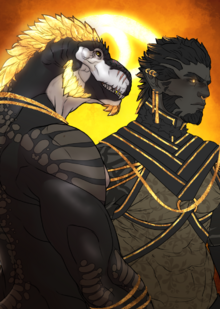
- Name: Dari (left) and Tanthor (right) are the Allar and Kathar Gods of the Forgotten.
- Patron: No specific Patronage, they are for the Downtrodden, Forgotten and Unwanted.
- Symbols: Golden neck chains or other forms of personal restraint around the neck.
- Role: To bless even the weakest and most unwanted in society with strength to go on.
- Traits: Dignified, Charitable, Austere, Sharing, Seeking Equity over Equality.
- Temple: There currently is no Temple, it was demolished in Crookback for housing.
- Allies: Tanthor and Dari see any and all who want to be included in Regalia as Allies.
- Enemies: Tanthor and Dari see anyone who kicks down on the downtrodden as enemies.
- Rituals: Dari and Tanthor mostly give hope to the lost that there is still a place for them in the Everwatcher's Grace and the Regalian Empire. Rituals of Dari and Tanthor often involve charity and bringing care and warmth to the poor, the dispossessed, the unwanted, and to show compassion and no bigotry against those who look or act different. They involve rituals to combat racism, discrimination, and general radical inclusion, perhaps, even Vampires.
|
|
Prosperity Gods Mendes and Hor
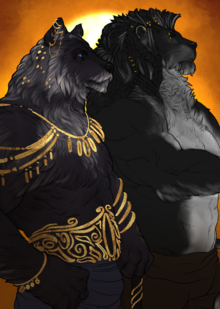
- Name: Mendes (left) and Hor (right) are the Gods of Prosperity and Wealth.
- Patron: Merchants, Bankers, Traders, Shopkeepers, Bureaucrats, the Filthy Rich.
- Symbols: The Golden Coins of Union, Regal Coins with the Eyes of the Everwatcher.
- Role: To bless the people with wealth and prosperity and good wit in commerce.
- Traits: Business Acumen, Opulent, Responsible, Self-Sufficient, Insightful.
- Temple: The Temple of Mendes and Hor is the Regalian Central Bank and Exchange.
- Allies: Mendes and Hor see anyone who spreads Order and Stability as Allies.
- Enemies: Mendes and Hor see anyone who spreads Anarchy and Chaos as Enemies.
- Rituals: It perhaps sounds ironic, but one of the most common forms of worship to Mendes and Hor is paying taxes. The act of paying taxes is considered virtuous, because it both shows a willingness to part with wealth, and a willingness to trust the State to do good by the people with said Taxes, and to contribute to communal greatness. Other rituals involve squeezing foreigners for money and signing unequal trade treaties with foreign merchants.
|
|
Allied Gods Sinnavei and Eirlys
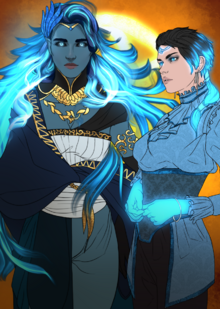
- Name: Sinnavei (left) Goddess of the Elves, Eirlys (right) Goddess of the Tribes.
- Patron: Solvaan, Elves, Breizh Ailor, Pre-Empire Tribes, Ancient peoples, heritage.
- Symbols: The Sollerian Mist-Gryphon, and the Breizh Santwr, Feather-Winged Warriors.
- Role: To show that non-believers and outsiders may find Solace and Alliance in Faith.
- Traits: Arcane, Enchanting, Ancient, Glory of Ages, Respect, Venerability of Age.
- Temple: Bryn Dwyfol in Kintyr, and The Skyward Palace in the capital of Solleria.
- Allies: Sinnavei and Eirlys see any who would join Regalia's ambitions as Allies.
- Enemies: Sinnavei and Eirlys see any who would obstruct Regalia's ambitions as enemies.
- Rituals: Rituals of Sinnavei and Eirlys involve (much like Tanthor and Dari) radical inclusion, but as opposed to Regalia's own citizens, that of outsiders. To ally with other faiths for the good in the world, to respect outsiders, to give them human decency and dignity, and to help them help the faith. It also involves healing racial tensions, and uncovering and sharing ancient lost knowledge to the world for the wisdoms that it may hold.
|
|
Burdened Gods Caan and Kaldric
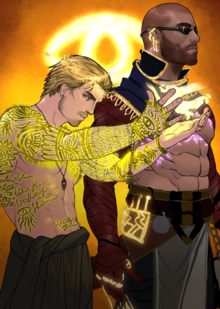
- Name: Kaldric (left) and Caan (right) are the Gods of Burdened but Beautiful Magic.
- Patron: Mages, Aelrrigan Knights, Arcane Researchers, those seeking Redemption.
- Symbols: Kaldric's horned bramble crown, and Caan's Arcane tome symbolisms.
- Role: To teach the faithful proper & virtuous Magic usage, and warn for corruption.
- Traits: Self-Sacrificing, Penitent, Humble, Pious, Stalwart, Holy, Paladins.
- Temple: The Hall of Golden Ascension in the Holy Agatha Mountains of Regalia.
- Allies: Those who use Magic respectfully, virtuous, and care for world & others.
- Enemies: Those who abuse Magic for selfish or hedonistic purposes and ego.
- Rituals: Kaldric and Caan rituals involve forms of self-sacrifice and penitence. Self-flagellation is one form of self-punishment practiced by some of their worshipers, but other forms of self-enforced humility through the praising or service of others are also common. Kaldric (once called Kristoph in life) is more for the self-loathing/punishing Mages and Occult, while Caan is more for the restrained and dignified Mages and Occult.
|
|
Cults
Cults exist in Unionism as "add-ons" for the Religion itself. While all Unionists by default worship the Gods and Goddesses listed in the Pantheon above, some Cults within Unionism worship additional gods that most of the main stream believers do not. These are holdouts from the old Schisms, that albeit while joining the main current of religious worshipers, still have some leftover of their old beliefs. Each Cult is represented by a single theological belief, and with Gods who are included by this theological belief, while all other aspects of the Religion are the same. It is possible to be a member of multiple Cults as they just add additional beliefs, but it is also possible to believe in one of the Cults, or none at all.
Evintarian Cult
The Evintarian Cult was established by the Evintarian Schisms many centuries ago when the Evintarian priests split off, and were expelled from Regalia and founded their own country in Aetosil. The Evintarian Schism happened, because the Evintarian Priests were of the opinion that Trans-Dimensional Entities (such as certain Demons) could become Gods too if they shed off their sinful nature and were blessed by the Everwatcher, which the main dogmatic branch rejected. The Evintarian Priesthood voted to join the Unionist Divine, and so they became a Cult that has included several Trans-Dimensional Entities as God Pairs.
- The God Pairs are not yet written, as the Art has not yet been updated.
Guided Cult
The Guided Cult has a long and troubled history, as Dogmatic Unionists tried to violently suppress so-called religious-critical movements that challenged the clergy by asking questions instead of blindly believing everything that was fed to them. The Guided Cult inevitably agreed to re-join the Unionist Divine, as the priests of the other groupings agreed to accept their Duality-God (each God representing two) entities, while also admitting some of their more free-thinking ideas in how to interact with the priests. While prior the priests could not be questioned, with the Guided Unionist re-interpretation, Priests were actively challenged to be questioned in their preaching and faith, so that everyone would become stronger in belief. The Guided Cult still exists, because they hold on to some of the so-called Dragon Gods, meaning to say that Guided Cult Unionists believe some Dragons can also be Gods.
- The God Pairs are not yet written, as the Art has not yet been updated.
Priestly Activities
Unionist priests are part of the so-called Covenant College. At the very top is the Secilly Council. Originally this organization had a leader called the Supreme Reverend, however the Supreme Reverend position was abolished when the last Supreme Reverend discovered insidious corruption within the religious community, tried to expose it, and was assassinated for it. To compensate, Conclave determined that the Dogmatic community should henceforth be ruled by a Council of elder Arch-Everians. Below the Secilly Council, are the Arch-Everian, which are equivalents to Dukes in the Regalian Empire. They wield considerable power and rule over vast areas of land, subdivided into Everies. Below the Arch-Everian is the Everian, or just the average priest. Each Everian administrates an Everie, which is usually a piece of land donated to the clergy where they maintain temples, shrines, and convents, while also producing crops and tending to cattle. Everians perform all religious tasks such as confession, preaching, hearing concerns, and simply taking care of Unionist needs like a social caretaker or mental health worker. Arch-Everians on the other hand are more administrative in that they take care of the treasury, any military attached to the religious orders, and communication between the Secilly Council and the vast wide-spread Unionist elements. Formally the Emperor is the leader of the Holy Seat, which is more of a group term for the Palace and the Secilly Council grouped together, but historically Emperors have interfered very little in the day to day running of the Everies, and as such, this fact is usually ignored, the Emperor being considered a completely independent entity. This has also historically separated the Emperor from controversy among the Everians, and vice versa.
Expanded Lore
The Expanded Lore section contains additional contextual information about the Gods. While the above sections will provide enough information to get a clear picture, there are some nuances and subtext to the Gods that are not apparent on first inspection, but that may be very useful for super-pious Characters. This section will tackle each God pair and discuss the various additional pieces of information available on them to the wider public and priesthood.
- This section is not yet written, as it will come very last when all other immediate Religion update tasks are done.
Trivia
- Unionism used to be mandatory for nobility somewhere during the second century after Cataclysm, though this Holy Law was removed when the war against the Skagger Horde ceased, and the Empire benefited more from including non-Unionists into the peerage. An exception had always been made for the Altalar nobles of Solvaan origins in Solleria however, called the Confessions of Melennar.
- Sectarian violence largely came to an end at the turn into the fourth century as the last attacks on Vultragon Unionist by state forces ceased, and an uneasy truce was signed between the Schism religious communities. They still do not see eye-to-eye, and the different Schismatic groups still prod at each other, but instead of murdering each other over sectarian differences, they mostly fight with words nowadays, a legacy of the Kleine Rechnung, the document that called for the truce.
- Despite Elen's absorption into Unionism, the Breizh still maintained a high level of cultural autonomy, some even clinging to old beliefs. As such, even when Magic became illegal in the Empire, the Breizh Aelrrigan Order continued to find and train Mages safely in their sanctuaries while the rest of the Empire turned to brutal oppression (and the Magic part of Elen was suppressed from dogma). Elen's faithful among the Aelrrigan Order are commonly cited as the reason why Magic acceptance eventually returned, and Elen's magical nature in theological teachings was returned.
| Accreditation |
|---|
| Writers |
MonMarty, FireFan96 |
|---|
| Processors |
Hemingway7 |
|---|
|
| Last Editor |
MonMarty on 10/15/2023. |
|---|
|
|---|
» Read more












